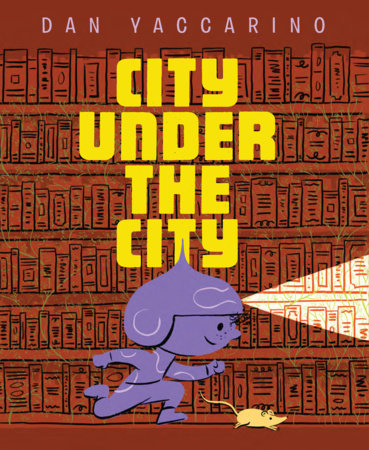 City Under the City
City Under the City
Written and illustrated by Dan Yaccarino
MineditionUS, 2022, 68 pp (unpaged)
ISBN: 9781662650895
In a futuristic world, technology makes everyone’s life easier from waking people in their pods each morning to brushing their teeth and choosing the books they have on their screens. Everyone walks around with their eyes on handheld screens, except for Bix who grows bored with her screen but can find no one, not even her family, to interact with. Bix resents the giant eyeballs, bright yellow spheres with one eye and a retractable arm, that constantly hover above, not only to help, but to monitor and control. One day, in trying to escape being watched, Bix follows a friendly creature and falls deep underground into a city under a city. She discovers many wonders, including a library full of books, where she spends hours reading and learns that the Eyes did not always exist. When she returns to her family, she brings a cartload of books and sparks a reading revolution, leading to an uprising against the Eye’s regime.
This picturebook is illustrated in ink on vellum and rendered digitally. The illustrations play a key role in providing many cues to the reader about the differences between the two worlds. The futuristic world is depicted in cool colors of light blue, purple, and white, reflecting the controlled and impersonal nature of a world ruled by technology. The city under the city, in contrast, is depicted in warm reds with hints of green sprouts. Details in the illustrations provide many important hints to this subterranean world and what occurred. Bix does not just enter any library, but a library guarded by the famous New York City Public Library lions. The walls of buildings in the abandoned city contain posters urging people to vote and warning of the dangers of the Eyes.
Messages about the dangers of technology going beyond making life easy, to controlling and monitoring our lives are clearly at the heart of this picturebook—particularly a world in which everyone’s eyes are on their screens, eliminating contact with each other. The power of history and reading are an even stronger message, particularly at a time when books are being challenged and banned. Through books, Bix realizes history provides evidence that there are many ways to live together within a community and that people have resisted authoritarian regimes that tell them how to live. The controlled reading in school holds no appeal for Bix who decides she must not like reading until she discovers new worlds in the underground library. The power of reading is reflected in the role of books in building resistance to the Eyes.
One interesting pairing with this picturebook is The King Who Banned the Dark by Emily Haworth-Booth (2019) in which a prince, who is afraid of the dark, passes laws to ban the dark when he becomes king, installing an artificial light to light the sky when the sun goes down. The king uses gossip and misinformation to instill fear of the dark and people do not realize the consequences of the new law until they lose the night. Just as in City Under the City, ordinary people eventually stage a resistance. This Book is Banned by Raj Haldar and Julia Patton (2023) is a fun pairing; in this case as the narrator introduces giraffes, hippos, birthday parties and so on, an objection is raised, and they are stricken from the book with a red pencil. Another relevant picturebook is The Great Banned-Books Bake Sale by Aya Khalil and Anait Semirdzhyan (2023) about a school in which “diverse books” are removed from the library and a child is unable to find any books that reflect her identity. She and her classmates hold a book sale to purchase diverse books for their Little Free Libraries, eventually leading to a change in the school policy.
These picturebooks are aimed at a similar younger audience, but there are also many novels about book banning for older readers, such as Ban This Book by Alan Gratz (2017), Attack of the Black Rectangles by Amy Sarig King (2022), and Finally Seen by Kelly Yang (2023). One final pairing is It’s a Book by Lane Smith (2010), in which a donkey with a laptop and a money with a hardcover book discuss the merits of their preferred formats.
Dan Yaccarino is a well-known U.S. illustrator, recognized for his bold stylized digital illustrations. He is also the creator and producer of several animated series. His picturebooks include The Longest Storm (2021), All the Way to America (2011), I am a Story (2016), Doug Unplugged (2013), and Every Friday (2012). He explores the merits of first-hand exploration in Doug Unplugged in which Doug, a robot, is plugged in every morning to start information download, until one day he unplugs and spends an exciting day of adventure and discovery.
Kathy G. Short, University of Arizona
© 2024 by Kathy G. Short

WOW Review, Volume XVI, Issue 4 by Worlds of Words is licensed under a Creative Commons Attribution-NonCommercial-ShareAlike 4.0 International License. Based on work by Kathy G. Short at https://wowlit.org/on-line-publications/review/xvi-4/6/
WOW review: reading across cultures
ISSN 2577-0527
